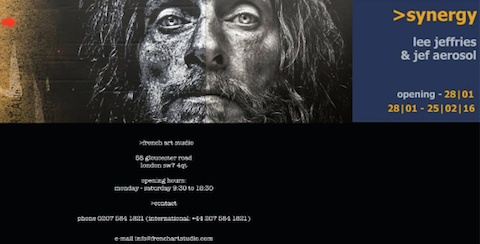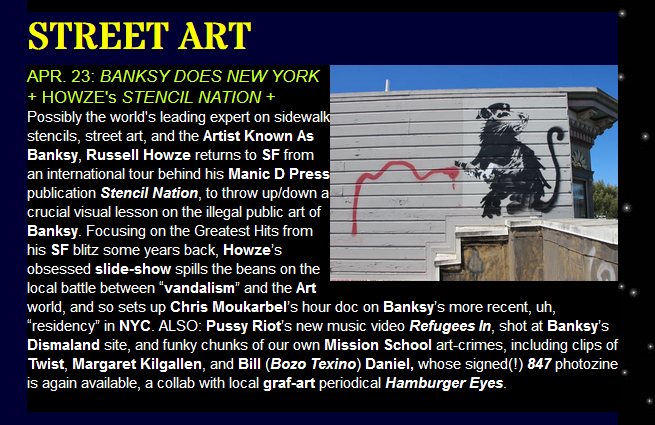Welcome to the new/updated site! Since 2002, your old-school website for all things stencils. Please consider donating what you can to support the much-needed upgrade. Photo, video, links, and exhibit info submissions always welcome. Enjoy and stay curious.
Other ways to support this site:
- Visit the Stencil Archive Support page to purchase a copy of Stencil Nation or take a tour.
- Find the Stencil Archives' best original photos on Instagram and flickr.
The Handcrafted Paper Stencils of a Kimono Designer Who Turned to Prints

The Handcrafted Paper Stencils of a Kimono Designer Who Turned to Prints
by Claire Voon on February 24, 2016 for Hyperallergic
For decades, the late Japanese artist Yoshitoshi Mori worked as an established kimono designer, using a stencil-based technique to dye his textiles. When he shifted his focus entirely to printmaking in 1960 after experimenting with the medium, he continued working with this layered design method. His resulting wealth of kappazuri — works produced with carefully hand-cut paper stencils — drew from the mingei folk art movement of the ’20s and ’30s that cherished handicraft. Looking further back into Japanese visual traditions, they also focus on subjects of pleasure widely depicted in the ukiyo-e of the Edo period, showing sensual courtesans, kabuki actors, and scenes from Japanese myth. Multilayered and composed of intricate shapes, Mori’s prints are best appreciated up close, an opportunity given by a current exhibition at Ronin Gallery that also features a handful of his sketchbook illustrations and paintings.
While stencil-based printmaking may conjure images with rigid forms, Mori’s prints are incredibly dynamic, composed of thick but fluid lines that constantly move the eye. One rendering of Taira no Tomomori, a warrior figure and popular character included in kabuki plays, juxtaposes swirling patterns on the man’s garments with dramatic hair that shoots from his head like a fountain. In another print, the voluptuous curves of a woman taking an afternoon nap seem to make her teeter on her back. Although his works do not necessarily involve movement, with many of them being portraits, his playing of negative and positive space introduces a delightful animation.
19 Feb: Swoon and Monica Canilao: Witch-Wife (SF, CA)

Witch-Wife will open at Chandran Gallery (459 Geary St., San Francisco) on Friday, February 19 from 7–9:30 p.m. and will run through April 1. ChandranGallery.com
The show will feature new works in both painting, block-prints, wheatpaste, sculpture, installation, and murals. For Brooklyn-based artist Swoon, this is the first time in a few years we have seen her in a gallery setting with this much new work. From our small preview last week, the installtion and sculptures are some of the duo's most ambitious works to date.
East Bay Express Preview, with interviews of artists, is here.
Icy and Sot: Stencils and Endangered Species
[When I'm not obsessed with stencils, I'm working for the amazing environmental NGO Center for Biological Diversity. CBD mostly protects endangered species, and I was excited last year when a co-worker told me Roger Peet (Justseeds) - an artist in my book Stencil Nation - was organizing murals across the USA for CBD. Eventhough I have co-painted some stencil peices for CBD, I'm out of the loop on this project (Hey, I'm doing other serious work for the org!). Much to my surprise, Icy and Sot have painted the latest mural with Roger and CBD. I'm grateful that the folks at Brooklyn Street Art hung out on the roof with them as they put up this great piece! - Russell]

photo by Jess X. Chen
ICY & SOT STENCIL AN ENORMOUS BLUE WHALE IN LA
Posted on January 21, 2016
Street Artists Icy & Sot are thinking about the ocean. More specifically they’re thinking about its largest resident, the blue whale.
Up to 110 feet long and 330,000 pounds, the blue whale literally can go to the deepest part of the ocean, or hang out on the surface.
This brand new mural is the brothers’ first stencil to address endangered species and it took a lot of blade wielding in their Brooklyn studio this month to cut the maritime scene before flying to Los Angeles to spray it out. Their work often speaks of social and political ills such as homelessness, war, arms proliferation, immigration. This is their very first that gives voice to those whose habitats are regularly contaminated and polluted by industry and individuals.
“We wanted to use a species that lives in water,” says Sot as they discuss the special project with the Justseeds Cooperative for the Center for Biological Diversity.
The Dude Company Paints a Commission (Video)
Nouveau film réalisé par Jérome DESLIENS , pour suivre les aventures de son film d'animation en cours de production, cliquez ici.
The Dude Company (FR)
Passionné par la technique du pochoir, Etienne Bergot alias The Dude Company a commencé à peindre dans la rue.
Ses voyages Outre Atlantique, en Europe et en Inde ont guidé ses créations.
Attiré par la ville, les paysages urbains restent son domaine de prédilection tout autant que la recherche du détail.
Ses nouvelles compositions, réalisées à partir des photos de récentes balades citadines mettent en scène Berlin, Bruxelles, Lille sa ville natale.
Elles constituent le début d’une collection signée The Dude Cities.
Jan 29: Synergy: Jef Aerosol, Lee Jeffries (London)
 JEF AEROSOL & LEE JEFFRIES
JEF AEROSOL & LEE JEFFRIES
"SYNERGY"
29/01 > 25/02/2016
opening / vernissage : 28/01/2016 (18h > 21h)
THE FRENCH ART STUDIO GALLERY, LONDON
Synergy – When photography and stencil interact
[synergy: interaction of elements to produce a combined effect greater than the sum of their separate effects]
‘Synergy’ is an artistic and social encounter between French street artist Jef Aérosol and British photographer Lee Jeffries.
Stemming from the original ‘Synergy’ exhibition that took place in Paris at Mathgoth gallery in March 2015, this collaboration casts a new light on a sensitive topic: the homeless.
A Lawyer Talks about Copyrights in Street Art
6 Things You Must Know About Copyrights in Street Art
Megan Ralstin for Art Law Journal
Artist’s rights in their street art, whether commissioned or guerrilla, has been in the news with some frequency lately, largely due to suits against American Eagle and Terry Gilliam. The slippery nature of copyright law has left many wondering where to draw the line between taking a photograph with street art in the background and taking a photo that infringes on a copyright. Unfortunately, there are no easy answers. As we have pointed out before, artwork used without permission may not be considered an infringement. Rather, unauthorized use exists on a spectrum with clear infringement on one end and fair use on the other.
Miami’s Wynwood district has become a hotspot for street art. Recently, American Eagle used murals from one of Miami’s most well-known street artists, AholSniffsGlue, in its latest advertising campaign. Thanks to Ahol’s suit against American Eagle, many Miami artists have been wondering what rights they may have in the art that they have created on public walls on public streets. At the same time, many photographers, journalists, and bloggers have been wondering if they are exposing themselves to liability when they photograph street art.
To help clear up some of the confusion, LegalLink, a legal resource for artists organized by Cannonball, hosted a lecture with a question-and-answer segment in Miami, Florida on September 17th. As well as answering audience questions, the presenter pulled representative comments from news websites to illustrate come commonly held misconceptions about copyright in public art. You can watch the entire presentation and download the PDF here.
New Uploads, Passing 21,000 photos
 21,000 uploads to the Stencil Archive. Here's to 1,000s more.
21,000 uploads to the Stencil Archive. Here's to 1,000s more.
Respect to all who have submitted, cut, painted, photographed.
Thanks to: Larry, Daryl, Mark, Mona, Pod
SJEL
Banksy
XLterrestrials
Paris (just one)
Mexico (just one)
FAILE
Colorado (just one)
East Bay, Cal
Kentucky
North Carolina
South Carolina (just one)
>NEW< PUSH
Eclair
Clarion Alley, SF
SoMa
Tenderloin (just one)
Upper Haight

